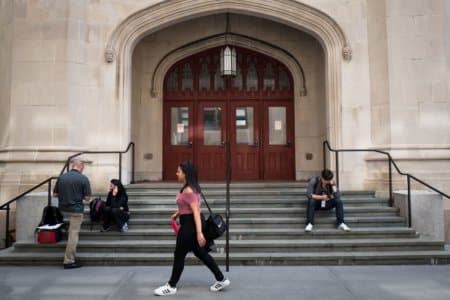
Many think it’s hard, and even impossible, for adults to learn a new language. Like most assumptions, that’s not quite the truth.
While there are challenges, it’s never too late to master a language. You may even do it as fast as a kid.
And that includes one of the most inspiring languages in the world: sign language.
A Helen Keller quote goes: “If I, deaf, blind, find life rich and interesting, how much more can you gain by the use of your five senses.”
As its name goes, this is a form of communication where you use your hands, face and mouth — most commonly used by the Deaf community as an alternative to spoken language.
If you are wondering how to learn sign language quickly and easily, we have the answers for you.

Sign language allows people in the Deaf community to communicate with each other. Source: Stephane De Sakutin/AFPSign language can be learned by anyone, hearing, partial or non-hearing.
Whether you want to connect with your Deaf friends or family or get extra credit at school, learning sign language can be a rewarding experience.
While no sounds will be heard, you’ll still be boosting your linguistic horizons, improving your brain power and even opening up new job opportunities.
Before we get into how to learn sign language, however, you’ll need to know some basic facts about what’s been called “the noblest gift God has given to Deaf people.”

Sign language involves hand gestures, facial expressions and body language. Source: Douglas Magno/AFP
How to learn sign language: Must-know facts
Sign language differs between regions. In the UK, they use British Sign Language (BSL), which is distinct from American Sign Language (ASL)
This may be challenging for ASL users to understand.
When deciding to learn sign language, your first step is to determine the specific type of sign language you want to learn based on your location and the spoken language used in your community.
You’ll have to consider the English vs ASL debate too.
English and ASL differ in several ways.
ASL has all the fundamental components of a language, including its own rules for constructing words, arranging them in sentences, and pronunciation.
But so does English. For one, English speakers may change the word order and alter their vocal pitch to form a question, whereas ASL users may raise their eyebrows, widen their eyes, and lean forward.
However, they do share some similarities. In English, certain phrases may be pronounced differently across different regions of a country,
ASL follows this as well. ASL has regional variations in signing rhythm, pronunciation, slang and signs used.
Benefits of learning sign language
Over 1.5 billion people worldwide experience hearing loss. By 2050, this number is expected to increase to 2.5 billion — which makes figuring out how to learn sign language a good move for today and in the future.
You can find jobs in fields such as education, healthcare, social work, interpretation and customer service, where the ability to communicate with deaf or hard-of-hearing people is highly valued.
Traditional industries want people who understand sign language too, especially for roles in HR and the growing field of Diversity, Equality and Inclusion (DEI).
By being able to communicate with deaf individuals, you can help bridge the communication gap and ensure that everyone feels included and understood.

Joining a course is a proven method on how to learn sign language quickly and easily. Source: Inti Ocon/AFP
5 easy and proven methods on how to learn sign language
Pro tip: Before you start signing, it is important to remember some basic etiquette.
As it is difficult to grasp someone’s tone, it is essential to allow a person to complete singing and indicate to you that it is your turn to talk before you start signing.
1. Take a sign language course
Learning sign language on your own can be challenging. As such, one of the best methods to learn sign language is to join a course that will introduce you to the fundamentals.
Not only is this the easiest way to learn sign language, it is also the quickest. Attending a course is a great opportunity to practice signing with different people.
Community centres, colleges or other educational centres offer day or evening classes. Qualified sign language tutors can help you work toward sign language qualifications. Classes are also a great way to meet new people and see the signs face-to-face.
Alternatively, you can choose to enrol in an online course that will teach you how to learn sign language. Numerous Deaf organisations and universities offer online courses to those with busy schedules or who are working.
Online courses offer flexibility as you can do it on your own time from the comfort of your own home.
Here are some universities offering courses on how to learn sign language:
- University of Northern Colorado – Online Bachelor’s Degree For ASL & English Interpreting
- University of Kansas – Bachelor’s Degrees in American Sign Language & Deaf Studies
- Lamar University – Bachelor’s Degrees in American Sign Language & Deaf Studies

Joining Deaf groups and organisations is one quick way how to learn sign language. Source: Getty Images/Getty Images North America/AFP
2. Learn from the community
In many cities, there are clubs or gatherings of Deaf individuals who meet regularly and communicate through sign language.
These are wonderful opportunities to meet new people who share a common experience of hearing loss and to improve your sign language skills.
Asking a Deaf friend to teach you some sign language can be a great way to forge new connections within the Deaf community.
If you already have friends or family members who use sign language, ask them to teach you some signs, making interactions with them easier.

US actress Marlee Matlin is an icon in Hollywood for being one of the first Deaf leading actresses. Source: Angela Weiss/AFP
3. Download a sign language app
Thanks to technology, anyone with a smartphone or tablet can learn ASL. This is due to the many apps available for learning sign language.
These apps include:
- ASL Coach: A free iOS app that offers short lessons to help you master the sign language alphabet
- ASL: Fingerspelling: Developed by the ASL resource Lifeprint, this iOS app is priced at US$3.99 and helps users improve their fingerspelling skills.
- Marlee Signs: Oscar-winning deaf actress Marlee Matlin started an iOS app called Marlee Signs, which is free and provides video lessons and fingerspelling practice for learning ASL.

Fingerspelling is the first in how to learn sign language. Source: Johannes Eisele/AFP
4. Learn the sign language alphabet
Familiarising yourself with the ASL alphabet is crucial in ASL learning, as it allows you to sign any word. Spelling out a word using the alphabet can be a helpful technique if you forget a sign.
Before engaging in conversations, it’s important to learn some basic words.
When starting to learn ASL, focus on learning common words and phrases such as “hello,” “thank you,” and “please.”
5. Learn online by watching videos
On YouTube and TikTok, there are thriving ASL communities where you can learn how to sign and see how new signs are invented and spread.
Short and can be repeated as many times are you like, this is a great option for someone who needs a more flexible approach.
Here are a couple of YouTube channels worth exploring:
- Dr Bill Vicars: An expert in ASL who is hard of hearing and holds several degrees in Deaf-centric studies. His YouTube channel showcases a wide range of ASL lessons, reflecting his genuine passion for the language.
- Laura Berg Life: Formerly known as “My Smart Hands,” this channel is specifically designed to teach ASL to both adults and young children. It offers videos demonstrating how to sign common phrases, read names and more.
Watching others use the language is one of the easiest ways to learn sign language. Several television shows have become more inclusive by including Deaf people.
TV shows like “Switched at Birth” has incorporated sign language into the show allowing viewers to learn the language as they enjoy it.
How to learn sign language: Best universities to join
Many academic institutions have taken the step to become more inclusive by offering programmes taught in sign language. Here are the some of the best deaf-friendly universities today:
Gallaudet University
Established in 1856, GU is the university to go to for deaf and hard-of-hearing students.
Undergraduate, graduate, and doctoral programmes are offered in an immersive environment centred around ASL.
Learning here is visual-oriented, with the full rights of the Dead and hard-of-hearing community protected upheld on all fronts.
Rochester Institue of Technology (RIT)
Rochester Institute of Technology’s (RIT) National Institute for the Deaf offers deaf and hard-of-hearing students an excellent education while equipping them with career-focused programmes to prepare for college and beyond.
As one of only three major universities in the US specialising in deaf and hard-of-hearing education, RIT creates a sense of community among its students during their college years.
The university provides support services, including note-taking, sign language interpretation, tutoring, job search assistance, and career counselling.
University of Bristol
The University of Bristol has a well-established reputation for being deaf-friendly.
It offers a British Sign Language (BSL) course and has a strong support system for deaf and hard-of-hearing students, including note-taking services, interpreters, and assistive technology










